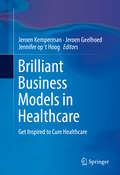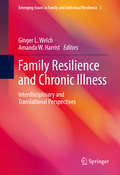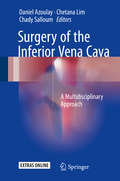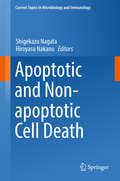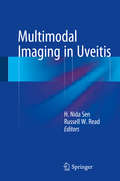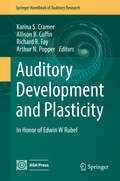- Table View
- List View
Medical and Surgical Treatment of Parathyroid Diseases: An Evidence-Based Approach
by Brendan C. Stack Jr. Donald L. BodennerMedical and Surgical Treatment of Parathyroid Diseases is an accessible and user-friendly guide, addressing the key points of parathyroid diseases using case studies, as well as hundreds of high quality images and illustrations. Written and edited by respected leaders in the field of parathyroid surgery, this book aids in the comprehension of innovative concepts and focuses on the latest in clinical research. Written for otolaryngologists and oncologists at various stages of experience, Medical and Surgical Treatment of Parathyroid Diseases includes chapters dedicated to parathyroid anatomy, physiology, and embryology, medical therapy for parathyroid disease (indications and pharmacotherapy), diagnostic imaging, surgical treatments, and special topics such as health services and healthcare economics related to parathyroid surgery.
Handbook of Cardiovascular Disease Management in Rheumatoid Arthritis
by Anne Grete SembThis book is a practical and up-to-date review that discusses the impact of traditional cardiovascular risk factors in patients with rheumatoid arthritis, the effect of rheumatoid arthritis disease activity and severity on cardiovascular comorbidity, and the influence of rheumatoid arthritis drug therapy on cardiovascular risk. This title also explores cardiovascular disease as a manifestation of rheumatoid arthritis and highlights the available methods for screening and diagnosing these conditions. Current and emerging therapies to aid clinicians in the daily management of their patients are also featured in this title. Busy healthcare professionals who are looking for a collaborative approach to these conditions will benefit from this comprehensive overview.
Brilliant Business Models in Healthcare: Get Inspired to Cure Healthcare
by Jeroen Kemperman Jeroen Geelhoed Jennifer op ‘t HoogThis exciting resource examines pioneering, successful business models in healthcare services, emphasizing bold and innovative entrepreneurship in creating care delivery that is accessible, affordable, and effective. Expert contributors supply fascinating case studies of visionary principles at work in hospitals, specialist care, eHealth providers, and insurers along with practical guidance on building and sustaining a vision, a brand, an organization, and a loyal base of clients, employees, and investors. Featured companies demonstrate how moving beyond conventional patient/provider, service/cost, and other relationships can translate into improvements that benefit clients’ health and stakeholders’ bottom line as well as the larger community and potentially the world. Coverage analyzes key attributes of these successful entities, detailing key challenges, funding issues, and especially breakthrough goals, including: Strengthening mutual caring and sharing. Letting prevention and self-management work. Patient-centered organization of information and everyday care. Deploying services and instruments to help customers take control. Implementing differentiation in specialized healthcare. The result is crucial takeaways for creating transformational business models in health fields. Approachably written and brimming with infographics, Brilliant Business Models in Healthcare provides inspiring role models for entrepreneurs, managers, consultants, and professionals in the healthcare sector, including providers, insurers, technology suppliers, and pharmacists.
The Breathless Heart: Apneas in Heart Failure
by Michele Emdin Alberto Giannoni Claudio PassinoThis book systematically focuses on central sleep apneas, analyzing their relationship especially with heart failure and discussing recent research results and emerging treatment strategies based on feedback modulation. The opening chapters present historical background information on Cheyne-Stokes respiration (CSR), clarify terminology, and explain the mechanics and chemistry of respiration. Following a description of the physiology of respiration, the pathophysiology underlying central apneas in different disorders and particularly in heart failure is discussed. The similarities and differences of obstructive and central apneas are then considered. The book looks beyond the concept of sleep apnea to daytime CSR and periodic breathing during effort and contrasts the opposing views of CSR as a compensatory phenomenon or as detrimental to the failing heart. The diagnostic tools currently in use for the detection of CSR are thoroughly reviewed, with guidance on interpretation of findings. The book concludes by describing the various forms of treatment that are available for CSR and by explaining how to select patients for treatment.
Handbook of Tuberculosis
by Jacques H. Grosset Richard E. ChaissonThis concise, clinically focused handbook offers a complete overview of tuberculosis and reviews the latest guidelines, treatment options, clinical trials and management of this disease. Handbook of Tuberculosis is a well-rounded book written by renowned researchers at the Johns Hopkins Center for Tuberculosis Research. The easily accessible text offers infectious disease specialists, pulmonologists, and other healthcare workers an excellent quick reference tool, with full color tables and figures enhancing the text further.Tuberculosis is a life-threatening lung infection that affects people of all ages. It is the second biggest cause of death from infectious diseases and is the most common cause of death amongst patients with HIV/AIDS. Education on the recognition of tuberculosis and the subsequent treatment of the disease is empirical to the prevention of wide-spread resistance. There is a lack of knowledge on how to treat coinfected and comorbid patients, this handbook offers the latest medical guidance and treatment options to equip physicians to manage such patients.
Family Resilience and Chronic Illness: Interdisciplinary and Translational Perspectives (Emerging Issues in Family and Individual Resilience #0)
by Ginger L. Welch Amanda W. HarristThis interdisciplinary volume offers theoretical, empirical, and practical insights into the strengths of families beset by chronic health issues. Featuring topics that run the lifespan from infancy to late adulthood, its coverage reflects both the diversity of family challenges in long-term illness and the wealth of effective approaches to intervention. The component skills of resilience in life-changing circumstances, from coping and meaning making to balancing care and self-care, are on rich display in a framework for their enhancement in therapy. The book’s expert contributors include tools to aid readers in the learning and teaching of concepts as they model respectful, meaningful research methods and ethical, non-judgmental practice. Among the topics covered: Helping families survive and thrive through the premature birth of an infant. Enhancing coping and resiliency among families of individuals with sickle cell disease. A family science approach to pediatric obesity treatment. Risk and resilience of children and families involved with the foster care system. Strengthening families facing breast cancer: emerging trends and clinical recommendations. The unfolding of unique problems in later life families. With its mix of practical and empirical expertise, Family Resilience and Chronic Illness: Interdisciplinary and Translational Perspectives has much to offer both researchers in the family resilience field and mental health practitioners working with clients with chronic illness.
L-Arginine in Clinical Nutrition (Nutrition and Health)
by Vinood B. Patel Victor R. Preedy Rajkumar RajendramThis text presents the application of current nutritional knowledge by physicians and dietitians and incorporates emerging fields of science and important discoveries. It contains seven major sections. Section 1: Basic Processes at the Cellular Levels, Section 2: Arginine Metabolism and Functions, Section 3: Arginine Status in Cells Related to Organ Damage and Disease, Section 4: Arginine Status and Use in Healthy Individuals, Section 5: Arginine and Diseases of the Gastrointestinal Tract, Section 6: Therapeutic uses of Arginine: Diabetes, Obesity and Cardiovascular Diseases and Section 7: Therapeutic Uses of Arginine: Cancer, Wound Healing and Infectious Disease. Written by authors of international and national standing, leaders in the field and trendsetters, Arginine in Clinical Nutrition is essential reading for nutritionists and dietitians, public health scientists, doctors, epidemiologists, health care professionals of various disciplines, policy makers and marketing and economic strategists.
Multiple Myeloma and Other Plasma Cell Neoplasms (Hematologic Malignancies #0)
by Meletios A. Dimopoulos Thierry Facon Evangelos TerposThis book is a comprehensive source of up-to-date information on plasma cell neoplasms. Key features include the provision of new criteria for the diagnosis of symptomatic multiple myeloma requiring treatment and the description of novel therapies for myeloma and other plasma cell neoplasms that have only very recently been licensed by the U.S. Food and Drug Administration. Examples include lenalidomide as first-line therapy, panobinostat in combination with bortezomib plus dexamethasone for relapsed/refractory myeloma, ibrutinib for Waldenström’s macroglobulinemia, and new therapeutic regimens for systemic amyloidosis and POEMS syndrome. Information is also provided on drug combinations that have shown encouraging results and are very near to approval. Other important aspects covered in the book are the role of different imaging modalities in workup and the significance of newly acquired data relating to prognosis and minimal residual disease. Readers will find Multiple Myeloma and Other Plasma Cell Neoplasms to be a rich source of knowledge that will be invaluable in improving patient management.
Surgery of the Inferior Vena Cava: A Multidisciplinary Approach
by Daniel Azoulay Chetana Lim Chady SalloumThis book addresses an urgent need, offering an updated, detailed and multidisciplinary review of surgery of the inferior vena cava (IVC). Over the past two decades, tremendous advances have been made in this field and related specialties. Many journals and/or textbooks on different surgical or medical specialties have reported on individual aspects, so it is high time to gather all of them in a single resource. To date, surgery of the IVC remains a major challenge, not only in terms of technical difficulties, but also in terms of perioperative management. The book sheds new light on cutting-edge developments, including: Innovations in imaging; Neoadjuvant and adjuvant treatments for tumors of or involving the IVC; Intraoperative anesthetic management; and Technical and technological advances in surgery. As such, it will be of a great interest to surgeons (cardiac, vascular and digestive) and urologists, as well as radiologists and anesthesiologists.
Myocardial Perfusion Imaging - Beyond the Left Ventricle: Pathology, Artifacts and Pitfalls in the Chest and Abdomen
by M. Elizabeth Oates Vincent L. SorrellThis book will serve as a comprehensive reference source and self-assessment guide for physicians and technologists who practice myocardial perfusion SPECT imaging. Readers will learn to identify a wide variety of findings apart from the left ventricle, including those in the chest, the abdomen, and the right heart. It is explained which findings are clinically relevant and related to the reason for the myocardial perfusion imaging examination and which are incidental, with or without important clinical ramifications. The coverage includes a wide variety of common and uncommon focal lesions (e.g., benign or malignant neoplasms) and organ/systemic diseases (e.g., emphysema, cirrhosis and its sequelae, cholecystitis, duodenogastric reflux/gastroparesis, end-stage renal disease) that may be detected with myocardial perfusion SPECT imaging. In addition, guidance is provided in the recognition of typical artifacts, which may appear either “hot” or “cold” on the raw (unprocessed) and processed SPECT images, and, thereby, in the avoidance of potential interpretative pitfalls.
RadTool Nuclear Medicine Flash Facts
by Bital Savir-Baruch Bruce J. Barron Eric JablonowskiThis book is a learning aid and reference tool that provides all the important information pertaining to radioactive tracers within a single, easy-to-read volume. It introduces a new learning methodology that will help the reader to recall key facts on each tracer, including production, physical and chemical characteristics, study protocols, mechanism of action, distribution, and clearance. In addition, normal and abnormal tracer distributions are graphically reproduced on an outline of the human body using multiple colors. The book will be of value for all radiologists and medical students seeking a reliable source of essential information on radioactive tracers that can be readily consulted during everyday practice and used in preparation for examinations.
Apoptotic and Non-apoptotic Cell Death (Current Topics in Microbiology and Immunology #403)
by Shigekazu Nagata Hiroyasu NakanoThis volume focuses on apoptotic and non-apoptotic programmed cell death, including necroptosis, pyroptosis, and ferroptosis, and presents recent findings in the field. It discusses the crucial role that apoptotic and non-apoptotic cell death play in various pathological conditions, such as skin diseases, inflammatory bowel diseases, and virus infections. Further, it highlights the mechanisms underlying the recognition and clearance of dead cells, and the subsequent biological responses triggered by phagocytosed macrophages and factors released from dying cells. Offering insights into cell death, it is a valuable resource for researchers and clinicians developing novel strategies to treat various diseases that are closely associated with cell death.
Cancer Vaccines (Current Topics in Microbiology and Immunology #405)
by Natalia Savelyeva Christian OttensmeierThis volume focuses on the laboratory and clinical experience with targeting viral onco-antigens, while also reviewing the approaches to targeting self-cancer antigens in cancers of non-viral origin, where self-tolerance has been a challenge. It emphasizes the importance of selecting the right vaccine platform to induce a successful immune response against cancer antigens. In addition, the volume discusses the advances made with genetic vaccines, including recent advances with DNA vaccines and the rapid transition of mRNA vaccines from the laboratory to bedside. The new avenues opening up for cancer immunotherapy underline the importance of combinational approaches using cancer vaccines with costimulatory antibodies, which may dramatically improve cancer treatment. This book is intended for all translational researchers and clinicians who aspire to develop novel vaccination approaches for cancer patients with unmet clinical needs.
Ruptured Abdominal Aortic Aneurysm: The Definitive Manual
by Benjamin W. Starnes Manish Mehta Frank J. VeithThis manual is designed to serve as the standard for the management of patients with ruptured abdominal aortic aneurysm (AAA) by means of modern techniques. All aspects are covered, from pathogenesis, clinical presentation, and diagnosis through to initial management, operative strategies, postoperative complications, outcomes and quality of life issues. The book is based on the experience gained at a leading U.S. institution (Harborview Medical Center, University of Washington) that treats up to 40 patients with ruptured AAA annually and is highly respected for its expertise in this medical emergency. The team at Harborview Medical Center has recently shown that the implementation of a structured protocol for the management of ruptured AAA, with emphasis on an “endovascular-first” strategy, dramatically reduces mortality and complications. This has led to a sea change in the way in which patients are managed. There is an increasing hunger for information on these codified protocols and Ruptured Abdominal Aortic Aneurysm: The Definitive Manual will be invaluable for both surgeons and critical care physicians.
Multimodal Imaging in Uveitis
by H. Nida Sen Russell W. ReadThis book is a comprehensive guide to the imaging techniques that have revolutionized the diagnosis and management of uveitis during the past decade, including optical coherence tomography (OCT), enhanced depth imaging, fundus autofluorescence, and wide-field angiography. In addition, the current role of the traditional (invasive) gold standard techniques, fluorescein angiography and indocyanine green angiography, is described. Among the newer imaging modalities, detailed attention is paid to the various OCT technologies such as spectral domain OCT, enhanced-depth imaging OCT, and enface swept-source OCT. Further individual chapters focus on imaging using adaptive optics, multiview OCT, and OCT angiography.Uveitis can affect virtually any structure in the eye, and imaging of these structures is critical in the diagnosis, prognosis, and management of the disease. Increasing use and better understanding of the different modalities described in this book are sure to improve our knowledge of disease mechanisms and likely outcomes.
Emerging Infectious Uveitis
by Soon-Phaik Chee Moncef KhairallahThis book reviews the various emerging infectious diseases that show a significant association with uveitis, describing and explaining their ocular manifestations with the aid of color illustrations. In addition, it presents brief reports of further emerging infections that are associated with uveitis in rare cases. The coverage is wide ranging, encompassing diverse emerging bacterial, viral, parasitic and fungal infections. Individual chapters are also devoted to important re-emergent diseases such as syphilis and tuberculosis, with the focus on new data on epidemiology, diagnosis and management.Emerging infectious diseases are defined as “those whose incidence in humans has increased within the past two decades or threatens to increase in the near future”. Emergence may be due to the spread of a new agent, to the recognition of an infection that has been present in the population but has gone undetected, or to the realization that an established disease has an infectious origin. This book will be an invaluable source of information on all aspects of uveitis in these diseases.
Surgical Quality Improvement (Success in Academic Surgery)
by Rachel R. Kelz Sandra L. WongThis book teaches the theories and concepts behind surgical quality improvement and explains the skills and traits needed to become a high quality provider. The editors aim to teach and inspire the reader to achieve high quality outcomes and strive for continuous improvement.
Waldenström’s Macroglobulinemia
by Véronique Leblond Steve Treon Meletios DimoploulosThis book sheds new light on clinical, biological and therapeutic data on the rare disease Waldenström’s Macroglobulinemia (WM) with the participation of widely-recognized experts, involved in this field. It represents the efforts of physicians, scientists and patients, all around the world, to better understand and cure this rare disease.Considerable advances in the diagnosis, treatment indications, response criteria, prognostic factors and treatment options have been made since Dr Jan Waldenström first reported this “new syndrome“ 70 years ago. Particularly instrumental in advancing of our understanding of WM have been the eight international workshops devoted to this disease. New, exciting molecular data have recently been reported, allowing us to revisit the oncogenic events leading to WM B-cell proliferation and to use newly available compounds targeting oncogenic pathways.
Hysterectomy: A Comprehensive Surgical Approach
by Ibrahim Alkatout Liselotte MettlerThis book initiates the descriptions of the practical performance of different hysterectomies with conventional and robotically assisted laparoscopy, laparotomy and vaginal surgery. Laparoscopic hysterectomy has been out as an additional technique for hysterectomies for the last couple of decades. As the necessary light, augmentation and advanced skill has only been introduced into this already 200 year old surgical procedure within the last few decades by laparoscopy, the editors aim to look at the laparoscopic procedures followed by the traditional techniques of hysterectomy with laparotomy and vaginal surgery.
Thrombosis and Embolism: Volume 1 (Advances in Experimental Medicine and Biology #906)
by Md. Shahidul IslamThis unique publication explores diverse themes relating to thrombosis and embolism, from basic research at cell and molecular level to the actual care, prevention, and treatment of diverse categories of patients suffering from such diseases. Chapters cover a variety of topics including thrombosis and embolism in surgical patients, cancer patients, pregnant women and children and adolescents, as well as treatment of the conditions by traditional anticoagulants, novel oral anticoagulants, thrombolytic therapy, endovascular treatment and embolectomy. Readers may explore cutting edge research, recommendations from major societies, contemporary guidelines, areas of controversy and directions for ongoing and future research.The book features comprehensive information ranging from molecular mechanisms of diseases to the clinical features, diagnosis, and therapeutic regimens for treating a variety of clinical conditions. It has a broad appeal to scientists and research students as well as busy clinicians engaged in patient care, who will all find something important and useful amongst these carefully selected chapters.
Atlas of Breast Tomosynthesis: Imaging Findings and Image-Guided Interventions
by Martin Sonnenschein Christian WaldherrThis superbly illustrated atlas of breast tomosynthesis covers all aspects and applications of the technology, which reduces tissue overlap and facilitates the recognition of small cancers. After clear explanation of basic principles of the technique, individual chapters address diagnostic criteria, indications, and use of breast tomosynthesis as a screening tool. The findings obtained in the full range of benign and malignant conditions, including postoperative changes, are then presented with the aid of a wealth of high-quality illustrations from case examples. Detailed attention is paid to the BI-RADS classification, bearing in mind the ability of tomosynthesis to reduce categorizations as BI-RADS 3 and 0, thereby decreasing the recall rate. The book concludes by examining tomosynthesis-guided interventions such as vacuum-assisted breast biopsy and galactography.
Auditory Development and Plasticity: In Honor of Edwin W Rubel (Springer Handbook of Auditory Research #64)
by Karina S. Cramer Allison B. Coffin Richard R. Fay Arthur N. PopperThis volume presents a set of essays that discuss the development and plasticity of the vertebrate auditory system. The topic is one that has been considered before in the Springer Handbook of Auditory Research (volume 9 in 1998, and volume 23 in 2004) but the field has grown substantially and it is appropriate to bring previous material up to date to reflect the wealth of new data and to raise some entirely new topics. At the same time, this volume is also unique in that it is the outgrowth of a symposium honoring two-time SHAR co-editor Professor Edwin W Rubel on his retirement. The focus of this volume, though, is an integrated set of papers that reflect the immense contributions that Dr. Rubel has made to the field over his career. Thus, the volume concurrently presents a topic that is timely for SHAR, but which also honors the pioneer in the field. Each chapter explores development with consideration of plasticity and how it becomes limited over time. The editors have selected authors with professional, and often personal, connections to Dr. Rubel, though all are, in their own rights, outstanding scholars and leaders in their fields. The specific audience will be graduate students, postdoctoral fellows, and established psychologists and neuroscientists who are interested in auditory function, development, and plasticity. This volume will also be of interest to hearing scientists and to the broad neuroscience community because many of the ideas and principles associate with the auditory system are applicable to most sensory systems. The volume is organized to appeal to psychophysicists, neurophysiologists, anatomists, and systems neuroscientists who attend meetings such as those held by the Association for Research in Otolaryngology, the Acoustical Society of America, and the Society for Neuroscience.
Nursing Care and ECMO
by Chirine Mossadegh Alain CombesThis book explores the unique aspects involved in the management of ECMO patients such as physiopathology and indications, setting up the device, monitoring ECMO and the patient, troubleshooting, ethical aspects and rehabilitation. For the past eight years, management of acute heart failure and Acute Respiratory Distress Syndrome (ARDS) patients has been improved by the development of short-term assistance devices, with ECMO as a first line treatment. This highly informative book provides essential insights for ICU nurses at ECMO centers around the world, who face the substantial challenges involved in the management of ECMO patients. Above all, it meets their training needs with regard to bedside monitoring for these patients, which has become a major issue. The editors and most of the contributors serve at La Pitié-Salpétrière ICU, France, which, in terms of the number of admissions and major publications produced, is one of the world’s leading authorities on ECMO.
Postoperative Care in Thoracic Surgery: A Comprehensive Guide
by Mert Şentürk Mukadder Orhan SungurThis book offers a comprehensive, up-to-date overview of optimal postoperative care in patients who have undergone thoracic surgery and discusses challenging issues that are of interest not only in the context of thoracic surgery but also more generally within the fields of anesthesia, intensive care, and pain medicine. The coverage ranges, for example, from use of non-invasive ventilation, extracorporeal membrane oxygenation, and new monitoring devices to fluid management, pain control, and treatment of arrhythmias. A key feature of the book is the exceptionally attractive list of authors, who represent the most authoritative experts on the topics that they address. The approach is appropriately multidisciplinary, acknowledging that in many centers thoracic anesthetists are responsible for care during the postoperative period. This book is exceptional in being devoted solely to postoperative care in thoracic surgery, even though the difficulties involved in thoracic operations sometimes exceed those of cardiac surgery, especially in the postoperative period.
The Eye in Pediatric Systemic Disease
by Alex V. Levin Robert W. EnzenauerThis book is the first of its kind to describe ocular manifestations of systemic diseases in the pediatric population. Written and edited by experts in areas of pediatric ophthalmology and genetics, this new text covers a multitude of topics in a comprehensive and cataloged fashion. The Eye in Pediatric Systemic Disease is designed as an in-depth and up-to-date reference work that is heavily referenced, thus allowing the reader ready access to the international supporting literature. Everything from ocular manifestations of hematologic disease, child abuse, psychiatric diseases, renal disorders, and vitamin disorders are covered, allowing readers to know what to look for in the eyes of children with a given systemic disorder. The Eye in Pediatric Systemic Disease is written in language that is accessible to ophthalmologists and pediatricians, as well as allied health care professionals.


